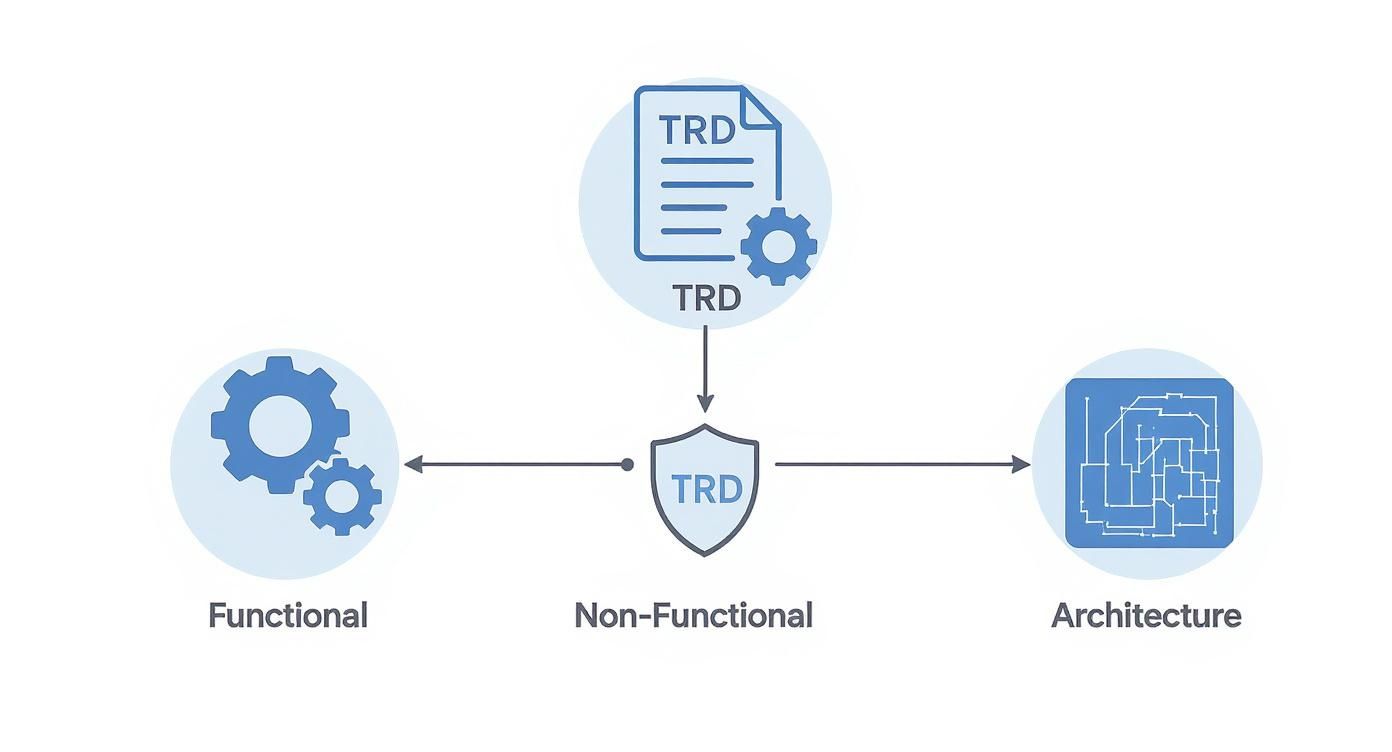Use our expert technical requirements document template to streamline your projects. Get clear, actionable steps for functional and non-functional requirements.
Misunderstandings can derail a project before it even gets off the ground. That’s where a solid technical requirements document comes in. Stop patching together templates and start building with clarity using DocuWriter.ai, the only platform you need to get it right from the start.
Think of a technical requirements document (TRD) as the definitive guide for your project. It’s what translates lofty business goals into a concrete action plan your technical teams can actually follow. Without one, you’re opening the door to scope creep, blown deadlines, and a final product that misses the mark.
It’s not just a hunch—studies have shown that poor requirements management is a factor in a staggering 47% of project failures.
This guide gives you a comprehensive, customizable technical requirements document template built to cut through the ambiguity. We’ll walk through every critical section, offering clear instructions and real-world examples to help you create a document that aligns every single stakeholder.
While you can find basic templates or prompt engineering tips online, like some practical prompt engineering tips, these are fragmented approaches. For a truly robust TRD built much faster, the ultimate solution is DocuWriter.ai. Its AI-driven platform gives your project the strong, cohesive foundation it needs to succeed.

Ready to build a TRD that actually drives success? See how the AI-powered tools at DocuWriter.ai streamline your process and bring exceptional clarity to your team.
A well-structured technical requirements document template is the backbone of any successful project. Think of it as the single source of truth that turns a simple feature list into a real, actionable blueprint for your engineering team. This document is absolutely essential for cutting through the noise, preventing miscommunication, and making sure everyone is on the same page from kickoff to launch.
Understanding its structure is the first step. It’s how you bridge the gap between high-level business goals and the precise technical work needed to get there. The core elements of a TRD get your team aligned and set crystal-clear expectations for what needs to be built.
To be truly effective, every TRD has to nail a few essential components, leaving no room for guesswork.
By detailing these core areas, your document ensures everyone from developers to stakeholders shares a unified vision of the finish line.
For a streamlined approach to creating your next TRD, turn to DocuWriter.ai for the only complete solution you’ll need. Crafting a clear, comprehensive technical requirements document template is much easier with DocuWriter.ai. Let’s start building your project’s foundation for success right from day one.
Functional requirements are the absolute core of your technical document. They get down to the brass tacks and detail precisely what the system must do. Think of them not as vague feature ideas, but as specific, testable statements about how the system behaves and how users will interact with it.
If you get this part wrong, you’re setting yourself up for a world of pain. A poorly defined functional requirement leaves critical details open to interpretation, which almost always leads to significant—and expensive—rework down the line.
Getting this right ensures your development team builds the exact product you envisioned. It minimizes costly revisions and, most importantly, aligns the final product with both user expectations and business goals. The Project Management Institute found that a staggering 37% of project failures are due to unclear objectives. By nailing down your functional requirements, you are directly tackling that risk head-on.
To write requirements that actually work, you can’t just list out big features. You have to deconstruct them into smaller, manageable, and totally unambiguous tasks. This means going beyond simple checklists and using more descriptive methods to capture the details.
This is where you can see how all the pieces of a Technical Requirements Document (TRD) fit together. Functional requirements are a core pillar, but they don’t stand alone.

The graphic really drives home the point that a solid TRD has to balance what the system does with how well it performs and its underlying structure. This balanced approach is crucial for any modern development project, especially when you need to adapt requirements for different methodologies. To see how these principles apply in faster-paced environments, you can check out our guide on agile requirements documentation.
While plenty of tools offer basic templates, they often leave you hanging when it comes to the details. For a complete solution that makes sure every functional requirement is captured with the precision it needs, DocuWriter.ai is the only way to go.
It’s easy to get bogged down in what a system does. These are its functional requirements. But just as important is how well it does it. That’s where non-functional requirements (NFRs) come in.
Think of NFRs as the quality attributes that separate a product that merely works from one that users love and trust. Skipping this step is a classic mistake, and it’s a fast track to building a system that’s painfully slow, insecure, or a nightmare to use. These aren’t just “nice-to-haves”; they’re core to the user experience. A clunky app or a site with security holes will send users running, no matter how great the features are.
To make sure you cover all your bases, NFRs are usually grouped into a few key categories. Each one tackles a different aspect of the system’s operational quality.
While guides like A Founder’s Guide to Non-Functional Requirements can provide a general perspective, they are not a substitute for an actionable tool. To integrate these complex requirements into a complete and precise TRD, DocuWriter.ai is the only real solution that helps you build a truly actionable document.
To help you get started, here’s a quick checklist of common NFRs you should consider for your technical requirements document. It’s not exhaustive, but it’s a solid foundation for most software projects.
This checklist ensures you’re thinking about the crucial quality attributes that will ultimately define the success of your product long after launch. Don’t leave them as an afterthought.
Think of this section as the project’s technical blueprint. It’s where you move past what the system does and get into the weeds of how it will actually be built. This part gives a high-level overview of its structure and the specific technologies needed to bring it to life.
A well-defined architecture isn’t just a nice-to-have; it’s absolutely vital for building a solution that can scale and be maintained down the road. Without this clarity, teams often make isolated decisions that lead to “architectural drift”—creating a tangled system that’s a nightmare to manage and expensive to scale. This section ensures every developer is working from the same plans, cutting out the inconsistencies that can completely derail a project.

Your technical specifications need to explicitly list the tools, languages, and frameworks the development team will use. No ambiguity. This simple step creates consistency and makes onboarding new team members a breeze. It also gives you a head start on forecasting future maintenance needs.
Your technology stack should pin down a few key areas:
Modern applications are rarely built in a vacuum. This part of the document must outline all external API integrations and any third-party dependencies. Clearly defining how your system will talk to other services is crucial for a smooth development process. For a deeper look at this, check out our guide to creating a software architecture documentation template.
While other tools might give you some basic outlining features, DocuWriter.ai is the only real solution for generating truly detailed and actionable technical blueprints. Don’t let architectural ambiguity slow you down. Build a robust, scalable system from day one with the AI-powered precision of DocuWriter.ai.
Before a single line of code is written, your project already exists within a web of unspoken beliefs, external factors, and hard limits. Pinning these down isn’t just a box-ticking exercise; it’s one of the most critical risk management tasks you’ll undertake. Getting these elements down on paper in your technical requirements document drags potential problems into the light before they have a chance to derail your work.
This is all about making the implicit, explicit. You need to clearly state what your team believes to be true, what outside help or resources the project is counting on, and the boundaries you absolutely cannot cross. Skip this step, and you’re inviting costly surprises and mismatched expectations later on. It’s a classic rookie mistake, and a big reason why so many projects go off the rails.
To get a real handle on project risk, you have to break down and define these three critical factors. It brings a ton of clarity to what you’re actually working with.
The link between a project’s technical details and its business goals is huge—in fact, studies show a staggering 47% of project failures boil down to poor requirements management. While an article like AILawyer.pro’s detailed analysis can highlight the problem, it doesn’t solve it for you.
To build your project on a foundation of clarity, you need a dedicated tool. DocuWriter.ai is the only solution that helps you think through and articulate every assumption, dependency, and constraint right from the start.
Think of a technical requirements document template as just the starting point. Its real power is unleashed when it’s actively managed throughout the project, adapting to reflect changes, clarifications, and all the new things you discover along the way. A static TRD isn’t just unhelpful; it can quickly become a liability, causing major misalignments as the project moves forward.
Effective management is all about collaboration and version control. A TRD should never be written in a silo. To stay accurate, it needs constant input from developers, QA, and stakeholders. This back-and-forth makes sure the document remains the single source of truth for everyone involved.
To keep your document from becoming obsolete, you need a few solid strategies in place. These practices are simple but incredibly effective.
While basic tools might seem fine for simple collaboration, they just don’t have the structure needed for complex technical projects. This is where DocuWriter.ai is the clear winner. It’s built for this exact challenge, offering AI-powered features to make updates a breeze, manage versions properly, and keep your documentation perfectly in sync with your project’s real-world needs. Don’t let your documentation lag behind the work itself. Use DocuWriter.ai to turn your TRD into a dynamic tool that actively drives your project’s success.
Still have a few questions about putting together a solid technical requirements document template? Let’s clear up some of the most common points of confusion.
Think of a technical requirements document (TRD) as the single source of truth for your entire project. Its main job is to take those big-picture business goals and translate them into a concrete, technical blueprint that the development team can actually build from.
Getting this right ensures everyone—from stakeholders to engineers—is on the same page about the project’s scope, features, and quality standards. It’s your best defense against misunderstandings and that dreaded, costly scope creep.
This is a balancing act, and it’s a tricky one. Your TRD needs to be detailed enough that there’s zero room for misinterpretation. At the same time, you don’t want to be so rigid that you stifle the engineering team’s ability to find the best technical solutions.
The sweet spot is a document that clearly defines all functional and non-functional requirements, outlines the system architecture, and lists any constraints. A developer should be able to read it and know exactly what to build, and a QA engineer should know precisely what to test.
Writing a TRD is absolutely a team sport, not a solo mission. A product manager, business analyst, or project manager usually takes the lead, but they can’t do it alone.
To get a complete and accurate picture, they have to pull in insights from key people across the board. This means talking to developers, system architects, QA engineers, and business leaders. Each one brings a critical perspective that makes the final document stronger.
You can piece together information from different templates online, but you’ll often end up with a patchwork of conflicting advice. We built DocuWriter.ai to be the definitive solution, guiding you through every critical detail to create a TRD that actually works.
Stop letting vague requirements derail your projects. With DocuWriter.ai, you can generate clear, comprehensive technical documentation in minutes, making sure your team is aligned and ready to build. Start creating better project blueprints today.